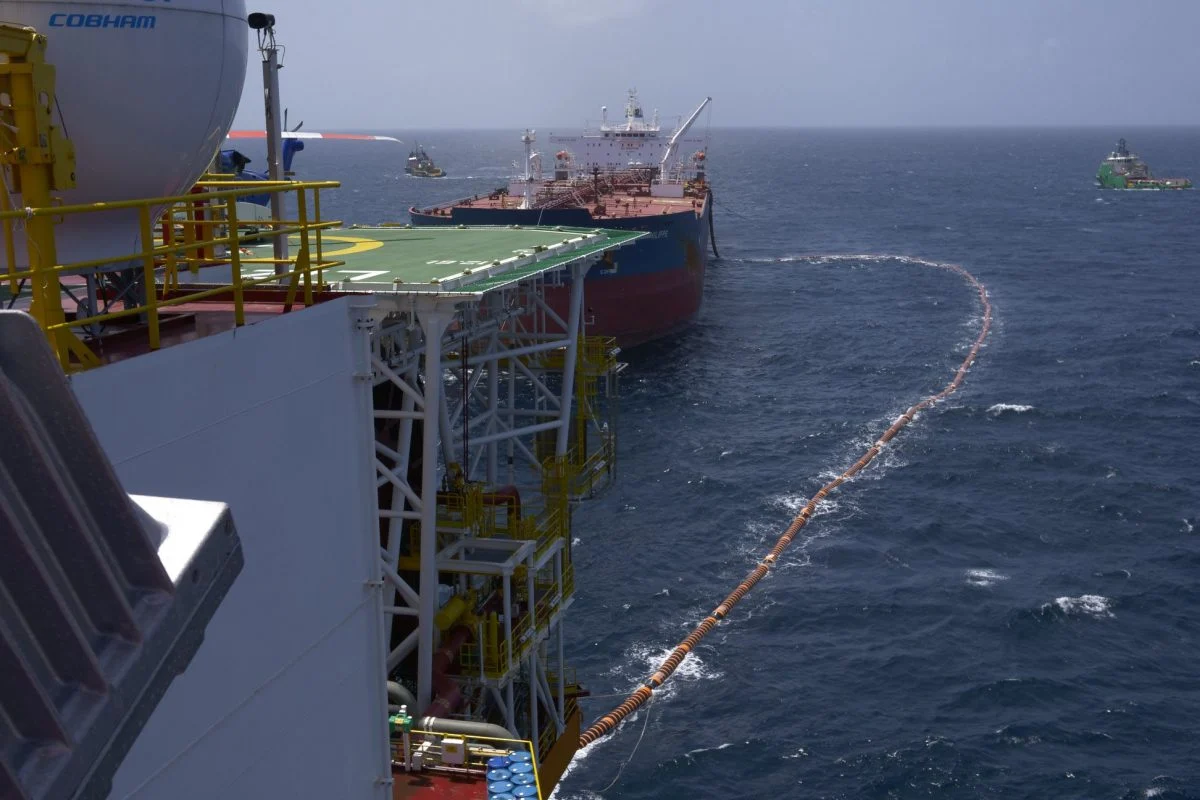
(Stabroek News, 7.Jun.2020) — Production at Exxon-Mobil’s Liza-1 project in the Stabroek Block, offshore Guyana, has plummeted from 80,000 barrels per day (bpd) to now between 25,000 and 30,000 bpd as compressor problems continue and the company would not increase flaring above about 15 million cubic feet of natural gas per day, Environmental Protection Agency (EPA) Director Dr Vincent Adams has said.
The current production level comes even as it was anticipated that by the middle of this month production would have reached Liza-1’s peak 120,000 bpb target.
It was expected that Guyana would have received its third one million crude cargo next month but at the current production level, it is unclear how long this country would now have to wait on that cargo and the revenues from it.
“They have encountered additional issues with the compressor valves and are mulling taking it out of the country because [the] current COVID-19 [pandemic] hinders requisite onboard expert personnel in an expeditious manner and the number of persons they want there,” Adams told Sunday Stabroek when contacted for an update on the situation.
“Having no compressor would have meant no reinjecting of the gas and thus total flaring, and they would have had to go back to the 80 cubic feet per day flaring. But we are not going back to that large volume and will keep at the 15 to 20 per day quantum and that means that production will have to be cut to accommodate this,” he explained and added that it would mean now producing at about “25-30 thousand barrels per day; down from the current 80,000 barrels [per day].”
When testing was carried out at Liza-1, it was determined that it is an associated gas well that comprises both crude oil and natural gas. As a result, at the Liza-1 operations, there are four drill centres with 17 wells in total: eight oil-producing wells, six water injection wells, and three gas reinjection wells.
The extraction of crude oil also results in raw natural gas associated with the oil being brought to the surface, and flaring of the associated gas is commonly used to dispose of it in the absence of infrastructure to make use of it. Meanwhile, during a reinjection application, the gas is injected into the reservoir via dedicated wells, forcing the oil to migrate toward the producing wells. The use of gas reinjection can increase the total resource recovery from an oil reservoir by up to 20% to 40%.
Exxon has said that it would use the gas for reinjection purposes and powering of the Floating Production, Storage and Offloading (FPSO) vessel offshore. It had also discussed with government bringing some of the gas to shore for domestic use and those discussions are currently continuing, the company said last week.
According to online oil and gas encyclopedia Petrowiki, “Associated gas is generally regarded as an undesirable byproduct, which is either reinjected, flared, or vented.”
‘Option’
When it signed a new Production Sharing Agreement (PSA) with the company back in 2016, the government had said that except for necessary testing, there will be no flaring of natural gas found offshore and that was in keeping with its commitment to developing a “green state.”
“We also determined that under no circumstances… there will be flaring of the gas,” Minister of Natural Resources Raphael Trotman had said when the new PSA with ExxonMobil’s subsidiary, Esso Exploration and Production Guyana Limited (EEPGL) and its partners Hess and CNOOC was announced in 2017.
The petroleum agreement, at Article 12, speaks to associated and non-associated gas and flaring. “If Contractor’s Notice includes a proposal to flare the excess Associated Gas in the Development Plan, then the Minister shall have the option to propose an extension of the response period provided in Article 6.6 for the offtake election to Contractor, until such time as the Minister can provide Contractor with a binding alternative proposal for development and use of the excess Associated Gas,” it states.
“If the Parties agree that the excess Associated Gas of an Oil Field has no commercial value, then such Gas shall be disposed of by the Contractor in the most economic manner consistent with good international petroleum industry practice, provided that there is no impediment to normal production of Crude Oil. All costs and expenses incurred by the Contractor in the production, use and/or disposal of the Associated Gas of an Oil Field as stipulated in Article 12.1 and those incurred in carrying out any feasibility study on the utilization of the excess Associated Gas shall be charged to the Development Cost of the Oil Field and shall be Recoverable Contract Costs. All costs incurred by the Government for the infrastructure and handling of excess Associated Gas which are not included in an approved Development Plan shall be at the sole risk and expense of the Government and will not affect the amount of Cost Oil and Profit Oil due to Contractor. The construction of facilities for the utilization and production of excess Associated Gas, if any, shall be carried out while a Petroleum Produc-tion License continues in force,” it adds.
‘Target’
Adams on Friday said that ExxonMobil has committed to rectifying the issue with its compressor and stop the flaring “by July” as its officials have lamented that the company has faced much embarrassment from the issue.
“We are pushing them to have it resolved swiftly; the earliest possible time would be what we are looking for but they are looking in July. Their target is no later than July,” he said.
Following revelations earlier this month that at the Liza-1 operations some 9 billion cubic feet of natural gas was flared, a number of persons as well as global environmental and human rights organisation, the Center for International Environmental Law (CIEL), pointed to the effects of the greenhouse gas emissions on the environment, as they condemned the act.
This newspaper had last month reported that glitches during production startup saw flaring of over 2 billion cubic feet of natural gas; a figure subsequently confirmed by the EPA to be over 9 billion cubic feet, as ExxonMobil assured that it would have from that week begin transitioning to using the gas for well injection purposes.
As it flayed Exxon for the large volume of flaring, CIEL called on the company to heed environmental pollution warnings and immediately stop the flaring, while adding that Guyanese should press for a pausing of works offshore and let ExxonMobil first answer “fundamental questions about its commitment to the environment in the country” while assessing its capacity to monitor the works offshore.
Last week, ExxonMobil told this newspaper that the reinjection process had begun and insisted that the volumes flared were in line with not only industry standards but with this country’s laws.
“The design for our operations in Guyana does not utilise routine flaring. Start up for the Liza Phase 1 involves temporary, non-routine flaring to fully commission the gas compression and injection systems for safe operations as outlined in the approved environmental impact assessment and permit,” the company’s local Public and Government Affairs Advisor Janelle Persaud said.
“The Liza Phase 1 project design eliminates routine flaring by using produced gas to power the Liza Destiny FPSO vessel and by reinjecting gas into the reservoir to conserve the gas and to improve oil recovery, thereby reducing emissions compared with traditional methods. We have successfully started up the gas handling system and begun gas injection into the reservoir. We continue to safely complete final commissioning of the system. This process is operationally necessary, standard in the industry and consistent with related Guyanese laws,” she added.
But in giving an update on Friday, Adams said that problems still persisted and the company notified the agency to this effect.
The EPA Director pointed out that EEPGL “were flaring at 100%” up to May 8th and started transitioning to reinjecting on that day. “They started reinjecting the gas because they thought they had solved the problem with the compressor equipment. However, they encountered another problem with vibration of the machine, but they were able to cut back from the 80Mcf to 15Mcf per day; that is a reduction of about 80%. It has to now get the equipment to manage the extra 15M per day that is currently being flared,” Adams said.
While the flaring volumes have been reduced, Adams said the current volumes are still “a major disappointment and concern, not only to the EPA but [to] the Department of Energy and some extent GGMC [the Guyana Geology and Mines Commission].”
All three agencies have been in briefings with the company as they are given periodic updates on the situation.
‘COVID situation’
Current global and local COVID-19 restrictions have seen a delay in rectifying the problem as the current onboard technical crew have left for their homelands around the world.
“One of the frustrations is the COVID-19 problem. A lot of these experts were on board and when the whole COVID situation and [closing of borders] happened, they went to their home countries. That is why they are not on site right now. They [ExxonMobil] are trying to get them back but they are from the United States and Germany and they have to now get them into Guyana,” Adams explained.
“They are also trying to get some of them from Brazil but we [Guyana] are not accepting persons from Brazil so that is also stalled from that end,” he added.
An engineer from the German-owned global technological and engineering manufacturer Siemens has competed the mandatory 14-day COVID screening and quarantine and has been cleared to go offshore to assess the equipment.
As the compressor equipment was outsourced, the two manufacturing companies are now providing troubleshooting assistance and Adams said that the company is also exploring sending the equipment out of Guyana to be fixed.
The current flaring volumes, delays of personnel getting to the rig as quickly as the company anticipates, COVID-19 restrictions and now lowering of production per day volumes, has seen the company “actively mulling” bringing up the compressor equipment and sending it overseas for fixing.
“There are basically two companies and they are trying to get both. ExxonMobil outsourced this expertise. They might have to send the equipment out of the country,” the EPA Director said.
According to Adams, Exxon said that the current situation “is a major disappointment and concern” and has committed that the volume of flaring “will be a one-time occurrence.”
“They have also expressed that they said this is one of their biggest embarrassments and have given us the commitment that this will be a one-time. This commitment will be codified in future permits to be issued, such as the Liza-2, the Payara [wells]…this will not happen again and they have given us that assurance and commitment. Their management has expressed many, many times their disappointment,” he said.
__________
— By Marcelle Thomas
***

